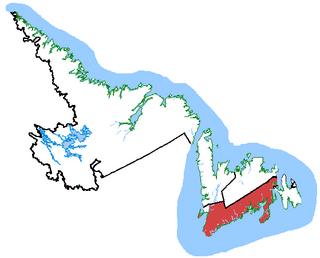Clarenville is a town on the east coast of Newfoundland in the province of Newfoundland and Labrador, Canada. Clarenville was incorporated in 1951. It is located in the Shoal Harbour valley, fronting an arm of the Atlantic Ocean called Random Sound.

Avalon is a federal electoral district on Newfoundland Island in Newfoundland and Labrador, Canada. It has been represented in the House of Commons of Canada since 2004.

Bonavista—Gander—Grand Falls—Windsor was a federal electoral district in Newfoundland and Labrador, Canada, that was represented in the House of Commons of Canada from 2004 until 2015.

Humber—St. Barbe—Baie Verte was a federal electoral district in Newfoundland and Labrador, Canada, that was represented in the House of Commons of Canada from 1988 to 2015.

Random—Burin—St. George's was a federal electoral district in Newfoundland and Labrador, Canada, that was represented in the House of Commons of Canada from 2004 to 2015.
Bonavista—Trinity—Conception was a federal electoral district in Newfoundland and Labrador, Canada, that was represented in the House of Commons of Canada from 1968 to 2003.
The Burin Peninsula is a peninsula located on the south coast of the island of Newfoundland in the province of Newfoundland and Labrador. Marystown is the largest population centre on the peninsula.

The 1832 Newfoundland general election came after many years of agitation against the British Parliament. Newfoundland was the last British colony in North America to gain representative government.
The Bonavista Peninsula is a large peninsula on the east coast of the island of Newfoundland in the Canadian province of Newfoundland and Labrador. It consists of 50 incorporated towns/unincorporated communities which have a population of 12,176 as of the 2016 Canadian Census. Bonavista is the largest population centre on the peninsula.

English Harbour East is a town in the Canadian province of Newfoundland and Labrador. It is located on the northeast side of Fortune Bay. Settled first by the Mi’kmaq of Newfoundland which used land on the “Neck” of the Harbour, they were joined in the early 1800s, by the English Dodge family and by Irishman Thomas Hynes Sr. European fishermen were first brought to the small community by English merchant family of Newman and Co. based in Harbour Breton, the firm of merchant John Gorman, and the Jersey firm of Nicholle and Co. The town had a population of 139 in the Canada 2016 Census.

The 1932 Newfoundland general election was held on 11 June 1932 to elect members of the 28th General Assembly of Newfoundland. This vote proved to be the final general election held by the Dominion of Newfoundland. As a result of a riot which occurred in 1932 due to Newfoundland's deteriorating economic situation, Prime Minister Sir Richard Squires dissolved the House of Assembly and called an election. His Liberals were reduced to two seats while Frederick C. Alderdice's United Newfoundland Party won 24 seats and was elected to government. The size of the House was reduced from 40 to 27 as an economy measure.

The 1859 Newfoundland general election was held in 1859 to elect members of the 7th General Assembly of Newfoundland in Newfoundland Colony. 18 Liberals and 12 Conservatives were elected. The Liberal Party led by John Kent formed the government.
The 1882 Newfoundland general election was held in 1882 to elect members of the 14th General Assembly of Newfoundland in the Newfoundland Colony. The Conservative Party led by William Vallance Whiteway formed the government.
The 1878 Newfoundland general election was held in 1878 to elect members of the 13th General Assembly of Newfoundland in Newfoundland Colony. The Conservative Party led by William Vallance Whiteway formed the government.

The 1928 Newfoundland general election was held on 2 June 1928 to elect members of the 27th General Assembly of Newfoundland in the Dominion of Newfoundland. The Liberal Party led by Richard Squires defeated the Conservative Party led by Frederick C. Alderdice and formed the government with the support of Fishermen's Protective Union members. Legislation had been introduced so that persons named to the Executive Council were no longer required to run for reelection. Helena E. Squires, elected in a 1930 by-election, became the first woman elected to the Newfoundland assembly.
Division No. 7, Newfoundland and Labrador is a census division in the Canadian province of Newfoundland and Labrador, primarily comprising the Bonavista Bay region. Like all census divisions in Newfoundland and Labrador, but unlike the census divisions of some other provinces, the division exists only as a statistical division for census data, and is not a political entity.
Bonavista—Burin—Trinity is a federal electoral district on Newfoundland Island in Newfoundland and Labrador, Canada, that has been represented in the House of Commons of Canada since 2015.

The following outline is provided as an overview of and topical guide to Newfoundland and Labrador.

Churence Rogers is a Canadian politician from Newfoundland and Labrador, who was elected to the House of Commons of Canada in a by-election on December 11, 2017. He represents the electoral district of Bonavista—Burin—Trinity as a member of the Liberal Party of Canada caucus.










